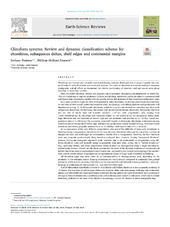| dc.description.abstract | Clinoforms are inclined and normally basinward-dipping horizons developed over a range of spatial and temporal scales in both siliciclastic and carbonatic systems. The study of clinoform successions underpins sequence stratigraphy and all efforts to reconstruct the relative partitioning of reservoir, seal and source rocks along shoreline to basin-floor profiles. Here, we review clinoform research and propose a more systematic description and classification of clinoforms. This is a crucial step to improve predictions of facies and lithology distribution within shoreline to continental shelf and abyssal plain successions, together with the genesis, drivers and dynamics of their constituent sedimentary units. Four basic clinoform types are here distinguished in delta/shorelines, lacustrine and marine environments, on the basis of their overall spatial and temporal scale, morphology, outbuilding dynamic and geodynamic and depositional setting: (1, 2) delta-scale clinoforms, which in turns are sub-divided into shoreline and delta-scale subaqueous clinoforms; (3) shelf-edge clinoforms; and (4) continental-margin clinoforms. Delta-scale clinoform sets are tens of metres high and typically represent 1–103 kyr, with progradation rates ranging from 1,000–100,000 m/kyr for shorelines and “subaerial deltas” to 100–20,000 m/kyr for subaqueous deltas; shelf-edge clinoform sets are hundreds of metres high and are nucleated and accreted in 0.1–20 Myr (usual progradation rates of 1–100 m/kyr) by successive cross-shelf transits of delta-scale clinoforms; continental-margin clinoform sets are thousands of metres high, hallmark key geodynamic/crustal boundaries (e.g., continent/ocean transition) and slowly prograde basinwards in ca. 5–100 Myr, with typical rates of 0.1–10 m/kyr. As a consequence of the very different progradation rates and of the difficulty of large-scale clinothems to backstep during transgressions, shorelines are the most dynamic clinoforms with regards to position, continental margins the least, and shelf-edges are intermediate. Shortly after a transgression, therefore, the four clinoform types may prograde synchronously along shoreline-to-abyssal plain transects, forming “compound clinoform” systems. During the subsequent regressive cycle, however, due to the dissimilarity in progradation rates, different clinoform types will normally merge progressively with each other, giving rise to “hybrid clinoforms” (e.g., shelf-edge deltas), and fewer depositional breaks-in-slope are distinguished along a single shoreline-to-abyssal plain transect. Overall, all clinoform systems are the result of the dynamic evolution of compound and hybrid clinoforms along a temporal and spatial continuum, regulated by the cyclical backstepping of the smaller-scale system within natural progradational-retrogradational cycles of larger-scale clinothem outbuilding. All clinothem types may show either an accretionary/active or draping/passive style, depending on the proximity to the sediment source. Draping clinothems are nearly-always composed of condensed fine-grained sediments, while actively accreting clinothems can be composed of predominantly coarse-grained (i.e., reservoir-forming) or predominantly fine-grained (i.e., non-reservoir) lithotypes. A novel hierarchical classification scheme for both Recent and Ancient clinoforms is here proposed, consisting of 12 classes. The four basic clinoform types (delta-scale shoreline, delta-scale subaqueous, shelf-edge and continental-margin) are sub-divided into eight accretionary/active and draping/passive sub-types (8-division). Each accretionary sub-type is then sub-divided into a sandstone-prone and mudstone-prone variant (12-division), which can be at least tentatively predicted on the basis of the clinoform morphology, even in the absence of direct stratigraphic logs. | en_US |

